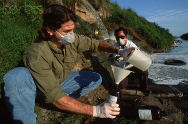 The nation has a right to expect clean water, but the reality is that increasingly its tolerating poisoned waters, contaminated with chemicals from agricultural runoff, prescription medicines, cosmetics, industrial pollutants, and more. Some of these contaminants, such as steroids, cannot be filtered out.
The nation has a right to expect clean water, but the reality is that increasingly its tolerating poisoned waters, contaminated with chemicals from agricultural runoff, prescription medicines, cosmetics, industrial pollutants, and more. Some of these contaminants, such as steroids, cannot be filtered out.
One of the benefits of living off-grid is that your water has not been through the system. Whether its from rain, or spring, or even bottled drinking water, its likely to be less contaminated than tap.
“The irony is that everybody looks at that [picturesque] scene and thinks that it’s great; everything is right with the world in Elliott Bay,” says scuba diver Mike Racine in the Chesapeake Bay in tonight’s PBS episode. “But in point of fact, not 100 feet away from where they are drinking a nice glass of wine off their white linen, there is this unbelievable gunk coming out of the end of this pipe.”
PBS’ Frontline tonight reflects on the state of the nation’s waterways some three decades after the Clean Water Act. Speaking to concerned citizens as well as scientists, corporate-folk, and politicians, Pulitzer Prize-winning journalist Hedrick Smith focuses on the Chesapeake Bay and the Puget Sound to tell the story of how we’ve neglected our hidden ecosystems and what it’ll take to restore them.
In Poisoned Waters, Smith speaks with researchers from the U.S. Geological Survey (USGS), who report finding genetically mutated marine life in the Potomac River. In addition to finding frogs with six legs and other mutations, the researchers have found male amphibians with ovaries and female frogs with male genitalia. Scientists tell FRONTLINE that the mutations are likely caused by exposure to “endocrine disruptors,” chemical compounds that mimic the body’s natural hormones.
The USGS research on the Potomac River poses some troubling questions for the 2 million people who rely on the Washington Aqueduct for their drinking water.
“The endocrine system of fish is very similar to the endocrine system of humans,” USGS fish pathologist Vicki Blazer says. “They pretty much have all the same hormone systems as humans, which is why we use them as sort of indicator species. … We can’t help but make that jump to ask the question, ‘How are these things influencing people?’”
“The long-term, slow-motion risk is already being spelled out in epidemiologic data, studies—large population studies,” says Dr. Robert Lawrence of the Johns Hopkins School of Public Health. “There are 5 million people being exposed to endocrine disruptors just in the Mid-Atlantic region, and yet we don’t know precisely how many of them are going to develop premature breast cancer, going to have problems with reproduction, going to have all kinds of congenital anomalies of the male genitalia, things that are happening at a broad low level so that they don’t raise the alarm in the general public.”
Smith also investigates the state of Puget Sound’s environment, where decades of pollution have endangered such species as orca whales, whose carcasses have shown high levels of cancer-causing PCBs.
“We thought all the way along that [Puget Sound] was like a toilet: What you put in, you flush out,” says Washington Gov. Chris Gregoire, who notes that about 150,000 pounds of untreated toxins find their way into Puget Sound each day. “We [now] know that’s not true. It’s like a bathtub: What you put in stays there.”
Smith reveals that some of today’s greatest pollution threats stem from urban sprawl and overdevelopment, as new housing and commercial developments send contaminated stormwater into rivers and bays, polluting local drinking-water supplies.
Smith speaks with scuba diver Mike Racine, who describes runoff into the depths of Seattle’s Elliott Bay as a “brown, noxious soup of nastiness that is unbelievable.”
“The irony is that everybody looks at that [picturesque] scene and thinks that it’s great; everything is right with the world in Elliott Bay,” Racine says. “But in point of fact, not 100 feet away from where they are drinking a nice glass of wine off their white linen, there is this unbelievable gunk coming out of the end of this pipe.”
In addition to assessing the scope of America’s polluted-water problem, Poisoned Waters highlights several cases in which grassroots citizens’ groups succeeded in effecting environmental change: In South Park, Wash., incensed residents pushed for better cleanup of PCB contamination that remained from an old asphalt plant. In Loudon County, Va., residents prevented a large-scale housing development that would have overwhelmed already-strained stormwater systems believed to contribute to the contamination in Chesapeake Bay.
The two-hour Poisoned Waters episode airs April 21 from 9-11 p.m. ET on PBS. Check your local listings for more information.

One Response
Makes you wonder what this is doing to the human population…